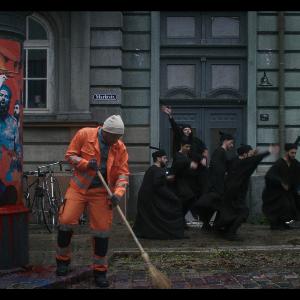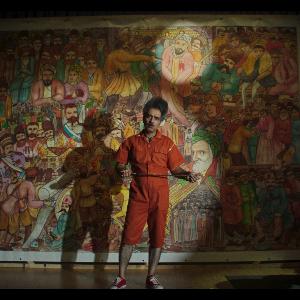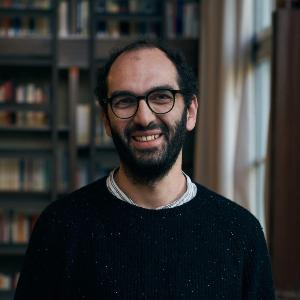A powerful picture says more than a thousand words
30 Jul 2024
Aydin Alinejad works at LMU and also writes scripts for screenplays. His latest film – Shahid – is currently in the movie theaters.
30 Jul 2024
Aydin Alinejad works at LMU and also writes scripts for screenplays. His latest film – Shahid – is currently in the movie theaters.

Scene from the movie Shahid | © Aydin_Alinejad/Shahid
In his capacity as a freelance scriptwriter, LMU employee Aydin Alinejad brings a cinematographic angle to the topics of globalization, climate change and migration that are studied at the global dis:connect research center. His latest film, Shahid, for which he wrote the script in collaboration with producer Narges Kalhor, premiered at the 2024 Berlinale, won a number of prizes and is currently showing at movie theaters across Germany.
You do two jobs at once: as an IT specialist at LMU’s Käte Hamburger Research Center, and as a freelance scriptwriter. How do these activities influence each other?
Aydin Alinejad: It really is a dream to work at the Käte Hamburger Research Center . While I am not actually involved in research work, I constantly have touchpoints with current research projects and findings, and I come into contact with fascinating scientists. Encountering so much mental stimulus is obviously very conducive to my writing. Again and again, I am exposed to topics, names, stories that inspire me. Then I get to either do my own research or engage in dialogue with the researchers themselves.
Shahid is the latest film for which you and producer Narges Kalhor wrote the script. What is it about?
The film is an autofiction that plays with elements of Narges’ biography. The main character wants to drop part of her name: “Shahid” means “martyr”, and for her it is a burden. The film traces her odyssey through the Bavarian bureaucracy while also exploring her family history and working with aspects of theater and the musical genre.
Do you also find that you can contribute aspects of your scriptwriting work to the research center?
My work on films has indeed opened up new assignments for me at the research center. The center brings together elements of the humanities and esthetics, as well as promoting artistic research. To this end, we also cultivate dialogue with cultural institutions. Next year, I am planning to develop a film series for the Werkstattkino cinema. Why? Because the issues with which our global dis:connect Research Center concerns itself are naturally also highly topical in the film industry.
These issues include climate change, migration, trade and all aspects of globalization, for example. And precisely these subjects are tackled via the medium of film. Whenever I attend one of our colloquiums and follow the debates, a film – in many cases one by a young international filmmaker who studied here in Munich – comes to mind and adds an interesting angle on the topic. On the other hand, I often think that science and artistic expression require very different ways of thinking.
To what extent does the scientific, analytical mindset sometimes get in the way of creative expression?
When I am writing, I have to set aside all scientific thought and forget the principles I was taught during my theater studies, such as that everything has to be concise and condensed. When you are writing a film script, the important thing to begin with is that things are true in a certain sense and that they are your own thoughts. Interestingly, the form is often the first thing that takes shape when Narges Kalhor and I work together: Every film needs its own visual idiom and, hence, its own narrative style. We take great care to ensure that content and form complement each other. The form lends structure to our work: You know what you want to say, and you know why you want to say it in precisely this way. In the case of Shahid, we knew that the film had to be fragmented and erratic. We work with repetition.
An image can say a great deal more than a word.Aydin Alinejad

Scene from the movie Shahid | © Aydin_Alinejad/Shahid
The film projects that you and Narges Kalhor make certainly have very powerful and distinctive imagery. What influences have been particularly important in this process?
I think a lot about imagery and visual language. I can’t speak for Narges, obviously, but I ask myself: Would we have developed this kind of imagery if we had been native speakers of German? I believe that is possible but unlikely. The fact that we don’t align with any “standard”, that we sometimes think in different, unusual ways, automatically shifts our focus to the imagery.
In Shahid, one strand of the narrative deals with a shared accommodation community where the members do a lot of talking. Later, we took most of what the people said and left it out entirely. Instead, we told the whole story through a single picture, a scene at a bus stop. It works really well. We learned that an image can say a great deal more than a word, and it can do so in a very short time.
Another important aspect is that our native language also works very well with images. In German, you have a separate verb for every little activity: to walk, to get lost, to depart, to arrive. In Persian, images are used to describe all these things. For example, you wouldn’t say “I miss you”, but “My heart is constricted for you”. Obviously, that can also have a subconscious influence on our work.
What does your shared writing process look like?
Narges and I are first and foremost very good friends. Being colleagues is secondary. The ideas for the films always come from her. We then talk about the idea, find the form, the images, the motifs. Sometimes, we write the dialogues separately and then review them together. Each of us contributes their own strengths: Narges writes more than I do and also directs the films. My focus is more on the dramatic composition and the research.
Are further projects already planned?
We are currently working on our next film. The work has gradually become easier and more efficient for us. For the first film we made together we wrote 19 versions! In the early days, it was really hard to communicate our vision within the German film industry. German is not our native language; and, as I said earlier, it is also neither the way we think nor our visual idiom. The success of our first films made a lot of things easier for us, and we have also gained more self-confidence. We know that the way we do things works. Right now, we are applying for funding to develop our next film script together.
Can you imagine ever reaching a point where you have to choose between writing and your work at the research center?
As I see it, my working life is really a luxury: It is exactly what I need. Working at the research center gives me both aspects, security and creative freedom. I can’t imagine working solely as a self-employed script writer. And I thoroughly enjoy my work at the research center. It is not just an inspiring work environment and a beautiful place, but also a place where you rub shoulders with beautiful intellects.

studied theater studies at the LMU and now works at the Käte Hamburger Research Center global dis:connect | © Käte Hamburger Kolleg dis:connect
Born in Tehran in 1981,Aydin Alinejad,worked on film script projects in Iran from his earliest youth, including assignments for well-known director and theater producer Ali Rafii. At the age of 28, he moved to Germany and began his theater studies degree course at LMU in 2010. His first film script took shape during his studies: As part of a project workshop at the Institute of Theater Arts, he penned the script for the film Nabila in 2013. The film was produced with the participation of Bavarian broadcaster BR and won the prize for the best film script at the Lyon International Film Festival.
After completing his master’s degree at LMU, Alinejad worked under Professor Christopher Balme while also pursuing his career as a script writer and dramaturgist. Since 2021, he has been responsible for IT and digital workflows at the Käte Hamburger Research Center global dis:connect, which is affiliated to LMU. At the same time, he supports the center’s research fellows in the field of scientific communication and continues to enjoy success as a writer: He and his creative partner Narges Kalhor have so far written the scripts for a total of four films.
Youtube: Trailer Shahid